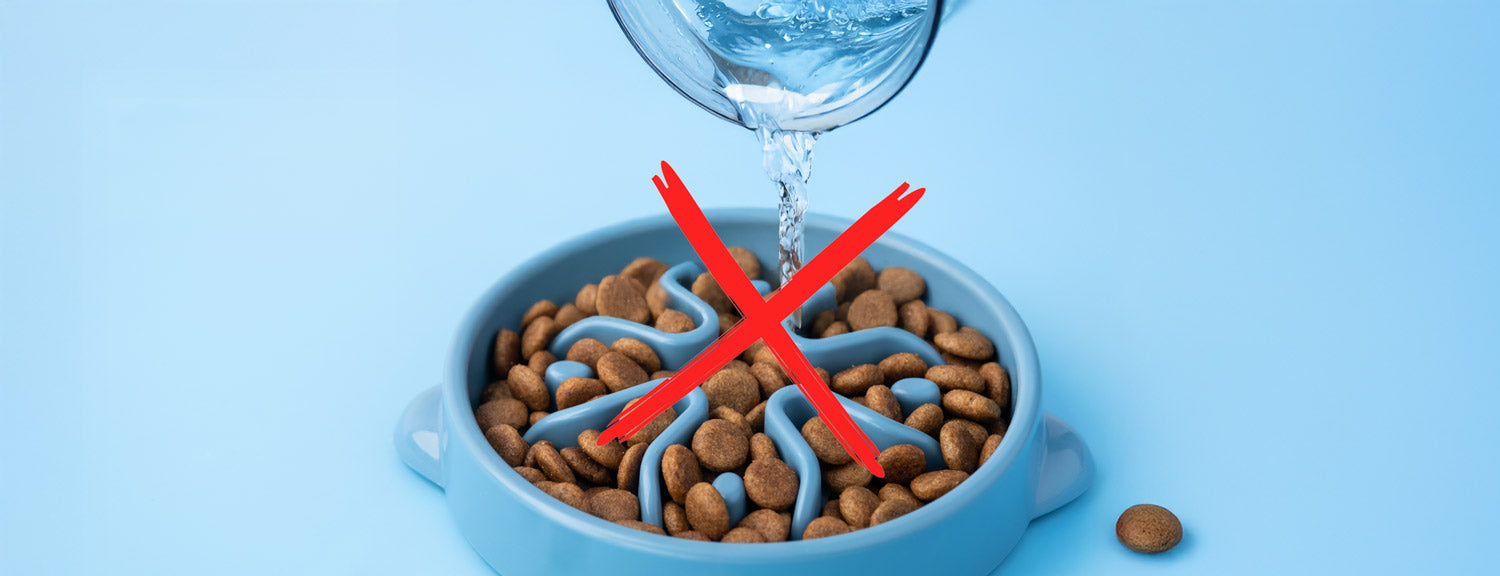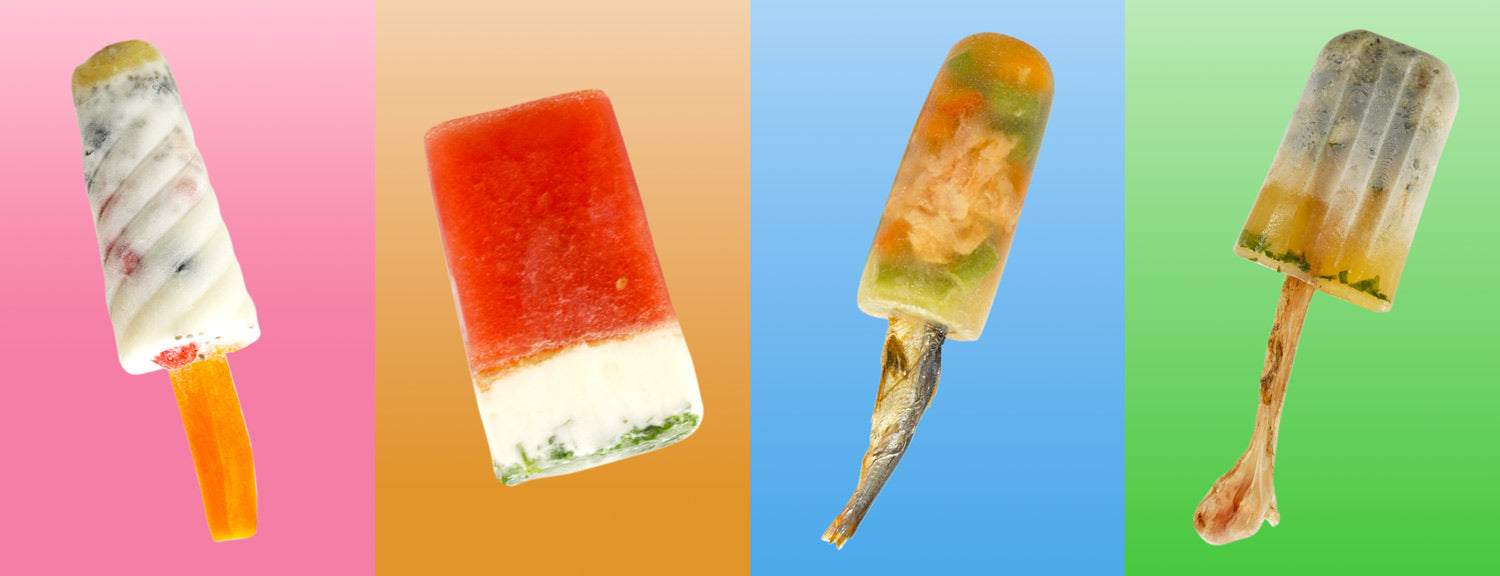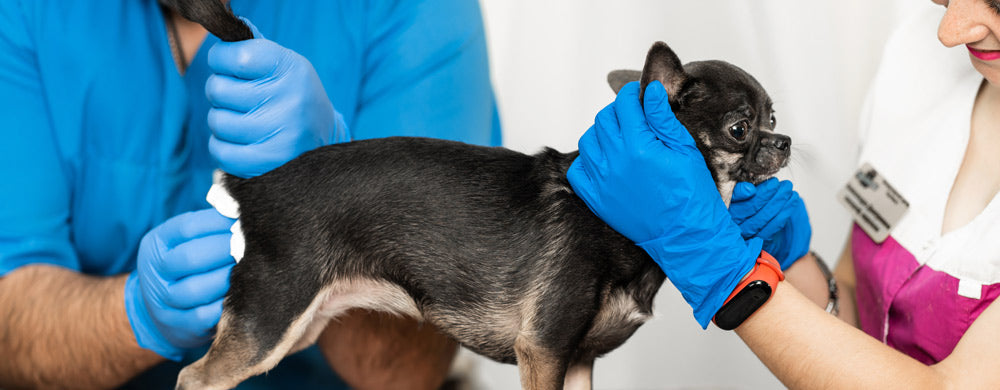Your basket is empty

Tear Stains in Dogs - Causes, Symptoms, Prevention, and Treatments
January 18, 2022 6 min read
Tear stains are a common issue in dogs, particularly those with light-coloured fur or short muzzles. Although not harmful, tear stains leave behind red marks around your pooch’s eyes and along their face that can be extremely hard to remove.
But where do tear stains come from? Tear stains can appear for a number of reasons, including eye infections, glaucoma, allergies, conjunctivitis, poor diet, and ingrown eyelashes. Some breeds are more prone to tear stains due to their facial shape, too.
If your four-legged friend is currently battling with tear stains, don’t panic. Here’s everything you need to know about the causes and symptoms of tear stains, as well as the best ways to treat and prevent them.
***
What Are Tear Stains in Dogs?
Tear stains occur when porphyrin, a pigment present in tears, builds up under your dog’s eyes, leaving behind reddish-brown stains.
The condition is most common in dogs with white or light-coloured fur, as well as those with short noses (brachycephalic breeds).
***
What Causes Tear Stains in Dogs?
There are many reasons why dogs get tear stains, including medical issues like conjunctivitis, glaucoma, eye infection, and environmental factors such as allergies and irritant exposures.
Some dogs are more prone to developing tear stains due to their body shape, so sometimes there are no underlying problems for why this condition occurs.
|
Glaucoma Glaucoma causes a build-up of pressure in your dog’s eye, leading to damage of the optic nerve. This serious condition will usually result in tear stains, discharge around the eyes, cloudy-coloured corneas, constant blinking/squinting, and a pupil that does not respond to light or is a different size to the other eye. |
Conjunctivitis Dogs with conjunctivitis will typically display symptoms like squinting/blinking, red or inflamed eyes, mucus/pus from the eyes, watery discharge, and eyelids that stick together. Conjunctivitis is caused by an inflammation or irritation of your dog’s conjunctiva (the soft tissue that lines the eyelids). |
|
Eye Infection Eye infections as a result of bacteria, parasites, or viruses usually cause excess tears, discharge, swelling, squinting/blinking, and red eyes. |
Ear Infection If your dog has an ear infection, it can cause the eye on the same side to produce more tears than normal, alongside other symptoms like head shaking/titling, odour from the ear, dark discharge, itchiness, redness/swelling around the ear, and crust scabs. |
|
Ingrown Eyelashes Ingrown eyelashes can be painful and irritating for your dog as they rub against the surface of the eye, which can cause damage. Symptoms of ingrown eyelashes in dogs include blinking/squinting and excess tears. |
Entropion Entropion is a condition where your dog’s eyelid rolls in, which results in the eyelashes hitting against the eye, causing irritation, swelling, redness, excessive tearing, corneal ulcers, discharge, pawing at the eyes, and squinting. |
|
Allergies Seasonal allergies, reactions to something in your dog’s environment, or irritating ingredients in their food can cause tear stains and excessive watering of the eyes. |
Irritant Exposure Dust, smoke, or other irritants can cause your dog’s eyes to produce excess tears in an attempt to remove the irritating substance. |
|
Stress and Improper Diet Stress, anxiety, or a poor diet can cause your dog’s eyes to water, so it’s important to identify why your dog is feeling more nervous or stressed than normal. You should also consider changing your dog’s diet to a more high-quality brand that doesn’t contain fillers or other unhealthy ingredients. |
Teething Puppies who are teething will usually produce more tears than normal, often leading to tear stains. Once puppies are old enough and are no longer teething, the issue typically disappears. |
***
Tear Stain Symptoms
One of the most noticeable symptoms of tear stains in dogs is red marks below your dog’s eyes. However, other signs that can indicate tear stains in dogs include:
- Damp fur around the eyes
- Discharge from the eyes
- Odour
If your dog has brown tear stains that produce a foul odour, it could be due to a yeast infection from the constant dampness of the fur around your pooch’s eyes.
***
Are Tear Stains Harmful?
Tear stains are not harmful themselves, but the presence of this condition could point to an underlying health issue. If you notice tear stains in your dog, it’s a good idea to book an appointment with your vet so they can investigate further.
***
Which Dog Breeds Are Prone to Tear Stains?
Dogs with light-coloured fur, shallow eye sockets, and short noses are most prone to tear stains, including the Shih Tzu, Maltese, Poodle, Bichon Frise, Pekingese, Pug, Cocker Spaniel, and Lhasa Apso.
***
Other Factors
Some other factors that can increase your pooch’s risk of developing tear stains include:

Small Tear Duct Openings
Each of your dog’s eyes has a tube that runs from the eye to the nasal cavity, allowing for excess tears to be drained through the nose. However, in dogs with small tear duct openings, the excess tears will leak over into the fur.
Large Tear Glands
Dogs with large tear glands produce bigger amounts of tears than normal.
Scarring
If your dog has suffered from a prior injury to their eye, the tear ducts may be damaged and unable to drain as effectively.
Blocked Tear Ducts
Dogs with blocked tear ducts will get a build-up of tears as the ducts will not be able to drain properly. Breeds like Cocker Spaniels and Poodles are prone to this condition.
Shallow Eye Sockets
Shallow eye sockets are common in brachycephalic breeds like the French Bulldog, Pug, and Pekingese. The eyes will usually bulge and protrude, sometimes to the point that the eyelids are unable to close fully.
Fur Around the Eyes
If your dog’s hair frequently gets into their eyes, it can wipe away tears, causing moisture to fall from the eye and along the skin.
***
How to Treat Tear Stains in Dogs
Before you go ahead and treat your dog’s tear stains, it’s important to get your four-legged friend checked by a vet so they can identify whether there is a medical issue behind your dog’s excessive tearing.
For eye and ear infections, your vet will most likely prescribe drops, as well as medication to treat any pain associated with the infection. If your dog’s tear stains are a result of entropion, your dog may need a surgical procedure to stop their eyelids from rolling in.
For tear stains cases due to allergies or irritants, you’ll need to figure out what is causing a reaction in your dog, then remove it from your dog’s environment/diet. Antihistamines can help reduce symptoms for dogs suffering from allergies.
Once you’ve identified the cause of your dog’s tear stains, you can manage the condition by keeping your pooch’s face clean and the fur around their eyes short.
Use a cotton pad soaked in warm water to clean the area, as well as a small amount of organic unrefined coconut on the tear stains to protect the skin and help remove minor marks.
Tear stain removal products can help eradicate particularly stubborn stains, such as TEARY, our natural tear stain supplement for dogs and puppies. It supports your pooch’s immune system while lubricating their mucous membranes to assist with removing and reducing tear stains.
TEARY is veterinary formulated and contains natural active ingredients like cranberry powder, Oregon grape root, marshmallow root, and eyebright. All of these work together to reduce bacteria build-up, soothe mucus membranes, treat eye-related problems, and keep your dog’s immune system in tip-top shape.
***
How to Prevent Tear Stains in Dogs
If your dog is at an increased risk of developing tear stains, whether that’s due to a health issue or genetic disorder, it’s a good idea to put in preventative measures to stop these pesky stains from occurring.
- Keep the face clean - Using a warm damp cotton pad or clean cloth, clean your dog’s face at least twice a day to remove excess tears and discharge.
- Cut fur around the eyes short - If your pooch has long hair around their eyes, cut it short (be very gentle!) to prevent irritation to the eyes and damp skin, the latter of which can contribute to yeast infections.
- Use porcelain, stainless, steel, or glass bowls - Plastic bowls can harbour bacteria that can increase your pet’s risk of developing infections.
- Feed a high-quality dog food - Make sure your dog’s food is free of fillers, artificial flavours, preservatives, and other unhealthy ingredients to keep your dog in good shape and their immune system working properly. You can check your current dog food’s nutritional score on the All About Dog Food website.
- Limit exposures to smoke, dust, and other irritants - Be careful when cleaning your house to make sure your dog isn’t exposed to excessive amounts of dust. You should also avoid smoking or using air fresheners and other strong-smelling products around your pooch.
- Use a tear stain supplement regularly - Tear stain supplements like TEARY not only work to keep your dog’s immune system at peak performance, but they also prevent the development of tear stains in the first place!
***
Final Thoughts
While tear stains themselves are not harmful to dogs, the presence of these unsightly marks can signal an underlying issue like glaucoma, eye infections, ear infections, and allergies. Some dogs are more prone to tear stains, but it’s still crucial that you get your pooch seen by a vet to make sure the issue is not caused by a health or medical concern.
Tear stains can be kept at bay by keeping your dog’s face and eyes clean, as well as face fur short. Supplements like TEARY can also be greatly effective for eradicating tear stains and stopping them from occurring in the first place.
Also in Pet Advice

Should You Add Water to Your Dog’s Kibble? Here’s What the Science Says
August 14, 2025 7 min read
Should you add water to your dog’s kibble? Discover the science-backed pros, cons, and better alternatives like bone broth and fresh food to improve hydration, digestion, and overall canine health...

DIY Frozen Dog Treats Your Pup Will Love
June 27, 2025 4 min read
Summer heat can be dangerous for dogs, making hydration more important than ever. Learn how to spot signs of dehydration, boost your pup’s water intake, and create fun, frozen recipes to keep them happy and healthy all season long.

Why Is My Dog Scooting? Common Causes and How Diet Can Help
May 09, 2025 4 min read
If your dog is scooting or smells fishy, it could be due to blocked or irritated anal glands. Learn what causes blocked anal glands, which dogs are most at risk, and how simple dietary changes—like adding fibre and anti-inflammatory nutrients—can help prevent recurring problems.

